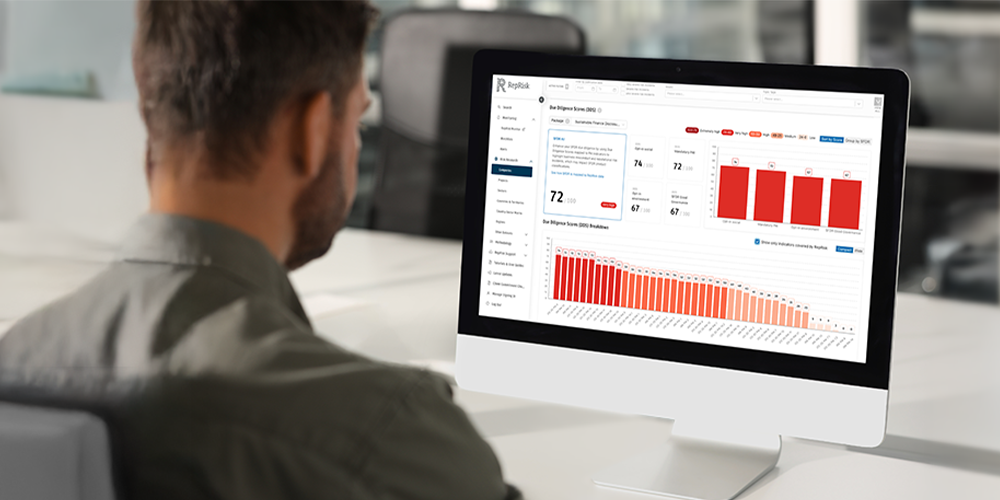September 11, 2019, Zurich, Switzerland
Responding to criticisms of ESG ratings
As ESG becomes more mainstream, investment management firms are being challenged to find the best way to incorporate ESG data into their investment process. While many investment managers now recognize that ESG factors are material, there is still some confusion and skepticism about the reliability and viability of ESG data.
One of the most pointed areas of criticism within the ESG space has to do with the perceived shortcomings of ESG ratings and scores.
To better understand these criticisms, we want to take this opportunity to briefly discuss the advantages and disadvantages of the different approaches to generating ESG data. Specifically, we will cover two key points: (1) Why self-reported data is not reliable data, and (2) How AI can unlock insights from ESG data.
1. Why self-reported data is not reliable data — especially when it comes to risks
In a world in which companies are 100% transparent and ESG disclosures are standardized, company selfreporting could be used to create robust ESG ratings that accurately reflect how a business deals with different issues. This world does not yet exist. Instead, companies are selectively transparent about what they disclose, which masks relevant ESG risks and calls into question the usability of such ratings to guide investment decisions.1
The major providers of ESG ratings – MSCI and Sustainalytics – have themselves admitted that there are issues with consistency and comparability of ESG disclosures, and as a result are now altering their research methodology to better incorporate external information.2 3
And how RepRisk addresses this problem
At RepRisk, we have always taken an outside-in approach by intentionally not considering any self-reporting in our research. Instead, we analyze more than 150,000 publicly available sources in 30 languages to identify material ESG risks related to specific companies or infrastructure projects. This helps ensure that our data is consistent and objective, allowing our clients to determine whether companies are actually walking the walk, instead of just talking the talk.
2. How AI can unlock insights from ESG data
Another increasingly popular approach among ESG data providers is using technology – such as artificial intelligence and machine learning – to comb through massive sets of unstructured data composed of everything from news articles to government reports. However, this approach comes with its own challenges, mainly the question of how to sort that data into specific and actionable insights that can be used to make better-informed investment decisions.
And how RepRisk addresses this problem
RepRisk pioneered the practice of ESG data science in 2006, becoming the first firm to leverage big data techniques to better understand ESG risks. We recognized from day one that the strength and scalability of any machine learning algorithm is dependent on the quality of the source material.
To maintain this quality, we rely on our team of 150+ highly trained analysts to curate and analyze each risk incident according to a systematic, rules-based methodology. Using this methodology, we have painstakingly built an annotated (i.e. human-labelled) dataset that dates back to January 2007. This dataset comes with two key advantages: (1) it allows us to deploy advanced machine learning to train our algorithms to be more accurate and effective, and (2) it gives us and our clients access to an unbroken time series of high-quality data that can be used for rigorous back-testing and quantitative analysis.
Thanks to this approach, we now have the world's largest and most comprehensive database on ESG and business conduct risks, with unique risk profiles for 300,000+ public and private companies and 100,000+ projects. Our AI and machine learning capabilities empower size and scale of our database, while our human intelligence adds depth and relevance to the data.
We would never claim that any individual ESG rating, data point, or metric is a perfect way to understand a company's behavior and performance. Instead, we view each of these data points as a tool that can be used to get a more complete picture of a company's behavior and intentions. Ultimately, it's still up to each investment manager to complement any third-party data with their own in-house research and investment processes.
Here are some additional sources that provide a perspective on the opportunities and challenges of using ESG data and ESG ratings:
August 2019: Aggregate Confusion: The Divergence of ESG Ratings (Published by MIT Sloan School of Management; Written by Florian Berg, Julian F. Koelbel, and Roberto Rigobon)
July 2019: Four Things No One Will Tell You About ESG Data (Published by Wiley; Written by Sakis Kotsantonis and George Serafeim)
May 2019: What Boards Need to Know About Sustainability Ratings (Published by Harvard Business Review; Written by Silda Wall Spitzer and John Mandyck)
April 2019: ESG Data, Ratings and Analytics: Vendors for All Seasons? (Published by Aite Group; Written by Paul Sinthunont)
March 2019: The ESG Data Challenge (Published by State Street Global Advisors; Written by Rakhi Kumar and Ali Weiner)
July 2017: ESG Reports and Ratings: What They Are, Why They Matter (Published by Harvard Business Review; Written by Betty Moy Huber and Michael Comstock)
About RepRisk
RepRisk is the world’s most respected Data as a Service (DaaS) company for reputational risks and responsible business conduct. Since 2007, RepRisk’s data has been trusted by the world’s leading banks, investment managers, Fortune 500 companies, sovereign wealth funds, and organizations such as the OECD and UN. Combining advanced AI with deep human expertise, and a proven methodology at the core, RepRisk’s solutions bring peace of mind, enabling clients to ‘know more, be sure, and act faster’. Our pioneering solutions help to strengthen due diligence processes across ESG topics, such as biodiversity, deforestation, human rights, and corruption, empowering clients to identify, monitor, and mitigate reputational, compliance, and financial risks. Headquartered in Zurich, and with offices in Toronto, New York, London, Berlin, Manila, and Tokyo, we stay close to clients and bring an independent lens to the industry. United by our shared belief in the power of data, our 400 people are proud to be setting the global standard for business conduct data and driving positive change through transparency.
Visit us at reprisk.com and follow us on LinkedIn.



